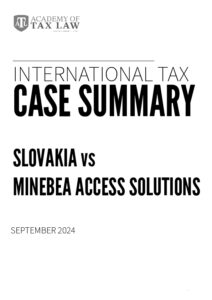Slovakia vs Minebea Access Solutions: CASE SUMMARY
Home » Case Library »
Slovakia vs Minebea Access Solutions: CASE SUMMARY
Case Information
- Court: Supreme Administrative Court of the Slovak Republic
- Case No: 2Sfk/36/2023
- Applicant: Minebea Access Solutions Slovakia s.r.o. (formerly U-Shin Slovakia s.r.o.)
- Defendant: Financial Directorate of the Slovak Republic
- Judgment Date: 24 September 2024
- Download the FULL JUDGMENT
Judgment Summary
The Minebea Slovakia transfer pricing case highlights the intricate challenges of aligning intra-group transactions with arm’s length principles. In this landmark ruling, the Supreme Administrative Court of Slovakia dismissed a cassation complaint filed by Minebea Access Solutions Slovakia s.r.o., a subsidiary of the Valeo Group. The decision upheld a tax authority adjustment that disallowed the deduction of €1,837,565.62 for management and technical services and increased the taxable base by €6,288,398 through the application of the median operating margin method.
The crux of the dispute revolved around the deductibility of costs related to services provided by Valeo Securite Habitacle S.A.S., a related entity. The tax authority found that Minebea failed to provide sufficient evidence substantiating the provision and economic benefit of these services. Additionally, the tax authority reclassified Minebea as a contract manufacturer with limited decision-making functions, rather than an independent entity, thus subjecting its transfer pricing to heightened scrutiny.
The ruling by the Supreme Administrative Court reinforced the principle that taxpayers bear the burden of proof to justify deductions and demonstrate compliance with transfer pricing regulations. The court found that the tax authority acted in line with Slovak tax law and OECD Transfer Pricing Guidelines when applying the Transactional Net Margin Method (TNMM) to adjust Minebea’s taxable income.
Key procedural issues, including restrictions on witness examination and the rejection of a power of attorney, were also addressed. The court dismissed these objections, ruling that they did not materially affect the fairness or validity of the tax authority’s findings.
This judgment has significant implications for multinational enterprises (MNEs) operating in Slovakia and beyond. It emphasizes the necessity of robust documentation, proactive tax risk management, and compliance with international transfer pricing standards to mitigate disputes. For revenue authorities, the case underscores the importance of clear methodologies and consistent application of transfer pricing principles.

